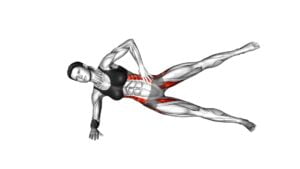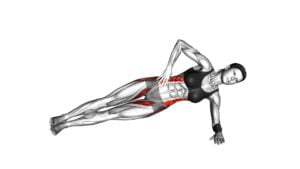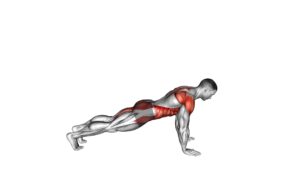Side Plank With Raised Leg (Version 2) (Female) – Video Exercise Guide & Tips

Are you looking to strengthen your core and tone your legs? Then you need to try the side plank with raised leg!
Watch This Exercise Video
In this exercise, you'll engage your obliques and glutes while balancing on one arm and lifting your leg. It's a challenging move that offers great benefits for your entire body.
Get ready to feel the burn and see results. Let's dive into this video exercise guide and learn some helpful tips for mastering the side plank with raised leg.
Key Takeaways
- Side plank with raised leg improves core strength and stability.
- Side plank with raised leg tones and strengthens the midsection.
- Side plank with raised leg activates muscles in the hips and glutes.
- Side plank with raised leg enhances balance and coordination.
Benefits of Side Plank With Raised Leg
To experience the benefits of the Side Plank With Raised Leg, position yourself on your side with your legs stacked and raise your top leg for increased challenge and engagement. This exercise is highly effective for improving core strength and stability. By engaging your core muscles, including the abdominals, obliques, and deep stabilizers, the Side Plank With Raised Leg helps to strengthen and tone your midsection.
As you lift your top leg, you also activate the muscles in your hips and glutes, further enhancing your overall stability.
In addition to core strength, this exercise also improves balance and coordination. The Side Plank With Raised Leg requires you to maintain a stable and aligned body position while balancing on one arm and leg. This challenges your proprioception, which is your body's awareness of its position in space, and improves your ability to control and coordinate your movements.
By practicing this exercise regularly, you can enhance your balance and coordination, which can be beneficial in various daily activities and sports.
Proper Form and Technique
Maintain proper form and technique by engaging your core muscles and keeping your body aligned during the Side Plank With Raised Leg exercise. Proper form is crucial to ensure that you get the most out of this exercise and prevent any potential injuries. Core strength plays a vital role in overall fitness, as it stabilizes your body and helps you perform daily activities with ease. By engaging your core muscles during the side plank, you aren't only strengthening your abs but also improving your posture and stability.
Balance is another key component in exercise performance. During the Side Plank With Raised Leg, it's important to find your balance and hold the position for the specified duration. This exercise challenges your stability and helps improve your overall balance. By practicing this exercise regularly, you can enhance your proprioception, which is your body's ability to sense its position in space.
Maintaining proper form and technique during the Side Plank With Raised Leg exercise will ensure that you engage the correct muscles and maximize the benefits of this exercise. Now, let's move on to modifications for beginners to help you gradually build up your strength and stability.
Modifications for Beginners
For beginners, start by performing the Side Plank With Raised Leg exercise with a bent knee for added stability. This modification allows you to build strength and balance gradually. To do this, start in a traditional side plank position with your forearm on the ground and your feet stacked on top of each other. Instead of extending your top leg straight, bend your knee and rest it on the ground in front of you. This will provide you with a solid base of support.
Modifications for pregnant women: If you're pregnant, it's important to consult with your healthcare provider before attempting any new exercises. Side planks can be modified for pregnant women by using a yoga block or bolster to support your upper body. Place the block or bolster under your bottom hand for added support and comfort. Additionally, instead of raising your leg, you can keep both feet on the ground and focus on engaging your core muscles.
Side plank with raised leg for seniors: Seniors can also benefit from performing modified side planks with raised legs. To make this exercise more accessible, start by performing a side plank against a wall for added support. Keep your bottom knee bent and your top leg extended straight. Lift your top leg a few inches off the ground and hold for a few seconds before lowering it back down. This modified version still targets the core muscles and helps improve balance and stability.
Remember to always listen to your body and modify exercises as needed to ensure safety and comfort.
Common Mistakes to Avoid
To avoid common mistakes and maximize the effectiveness of the Side Plank With Raised Leg exercise, focus on maintaining proper form and engaging your core muscles throughout the movement. Here are some tips for improvement:
- Avoid sagging hips: Keep your hips lifted and in line with your body to prevent them from sinking towards the floor. This will ensure maximum engagement of your core muscles.
- Don't forget to breathe: It's important to maintain a steady breathing pattern during the exercise. Inhale deeply through your nose and exhale through your mouth to stay relaxed and focused.
- Engage your glutes: To enhance the stability of your side plank, make sure to activate your glute muscles. Squeeze your glutes together to maintain a strong and balanced position.
- Maintain proper alignment: Align your body in a straight line from your head to your heels. Avoid leaning forward or backward, as this can put unnecessary strain on your spine.
- Start with a lower leg raise: If you're finding it difficult to raise your leg all the way up, start by lifting it only slightly off the ground. As you build strength and stability, gradually increase the height of your leg raise.
Advanced Variations and Progressions
To challenge yourself further and take your side plank with raised leg exercise to the next level, try incorporating advanced variations and progressions. These advanced modifications will target your core muscles even more intensely, helping you build strength and stability.
One advanced variation you can try is the side plank with leg reach. In this variation, you start in a traditional side plank position with your elbow on the ground and your body in a straight line. Then, raise your top leg up towards the ceiling and reach it forward as far as you can without compromising your form. This will engage your obliques and challenge your balance.
Another advanced progression is the side plank with leg lift. Instead of raising your leg straight up, lift it up towards the sky in a controlled manner. This movement requires even more core strength and stability.
Incorporating these advanced core exercises into your routine will help you continue to challenge and strengthen your core muscles. Remember to always maintain proper form and listen to your body. Start with a modification that feels challenging but doable, and gradually progress to more advanced variations as you get stronger.
Frequently Asked Questions
How Long Should I Hold the Side Plank With Raised Leg Exercise?
To get the most out of the side plank with raised leg exercise, it's important to hold the position for an appropriate amount of time. Aim to hold the exercise for at least 30 seconds on each side, gradually increasing the duration as you become more comfortable and stronger.
Remember to engage your core and keep your body in a straight line throughout the exercise.
For advanced fitness levels, you can try variations like adding a hip dip or lifting the top leg higher.
Can I Perform the Side Plank With Raised Leg Exercise if I Have Lower Back Pain?
Yes, you can still perform the side plank with raised leg exercise even if you have lower back pain. This exercise can actually help relieve lower back pain when done correctly.
However, it's important to listen to your body and modify the exercise if needed. You can try placing a folded towel or yoga block under your lower hand for added support.
Always consult with a healthcare professional before starting any new exercise program, especially if you have pre-existing conditions or injuries.
Is It Necessary to Raise the Leg During the Side Plank Exercise?
Raising your leg during the side plank exercise isn't necessary, but it can offer additional benefits.
By lifting your leg, you engage more muscles in your core and hips, increasing the challenge and intensity of the exercise.
However, if you have lower back pain, it might be best to avoid this variation and opt for other variations of the side plank that don't involve raising the leg.
Always listen to your body and choose the variation that feels most comfortable for you.
Will the Side Plank With Raised Leg Exercise Help Me Lose Belly Fat?
The side plank with raised leg exercise is effective for overall body strength. It targets multiple muscle groups, including the core, glutes, and shoulders.
While it can help strengthen these areas, it's important to note that spot reduction, such as losing belly fat, isn't possible with any specific exercise.
To achieve overall fat loss and a toned midsection, a combination of regular exercise, a balanced diet, and proper hydration is key.
Can I Do the Side Plank With Raised Leg Exercise if I Have a Knee Injury?
If you have a knee injury, it's important to avoid exercises that may exacerbate the issue. The side plank with raised leg exercise may put too much strain on your knee. Instead, consider alternative exercises that target your core without putting pressure on your knee joint.
There are several modifications available for those with knee injuries, such as knee-friendly plank variations or exercises that focus on strengthening the muscles around the knee.
Always consult with a healthcare professional before attempting any new exercises.
Conclusion
Incorporating the side plank with a raised leg into your workout routine can provide numerous benefits, including improved core strength, balance, and stability.
It's important to maintain proper form and technique throughout the exercise to maximize its effectiveness and prevent injury.
Beginners can modify the exercise by keeping the raised leg on the ground or using a stability aid.
Avoid common mistakes such as sagging hips or placing too much pressure on the supporting arm.
For advanced variations, try adding leg lifts or incorporating a resistance band for added challenge.

Author
Years ago, the spark of my life’s passion ignited in my mind the moment I stepped into the local gym for the first time. The inaugural bead of perspiration, the initial endeavor, the very first surge of endorphins, and a sense of pride that washed over me post-workout marked the beginning of my deep-seated interest in strength sports, fitness, and sports nutrition. This very curiosity blossomed rapidly into a profound fascination, propelling me to earn a Master’s degree in Physical Education from the Academy of Physical Education in Krakow, followed by a Sports Manager diploma from the Jagiellonian University. My journey of growth led me to gain more specialized qualifications, such as being a certified personal trainer with a focus on sports dietetics, a lifeguard, and an instructor for wellness and corrective gymnastics. Theoretical knowledge paired seamlessly with practical experience, reinforcing my belief that the transformation of individuals under my guidance was also a reflection of my personal growth. This belief holds true even today. Each day, I strive to push the boundaries and explore new realms. These realms gently elevate me to greater heights. The unique combination of passion for my field and the continuous quest for growth fuels my drive to break new ground.







